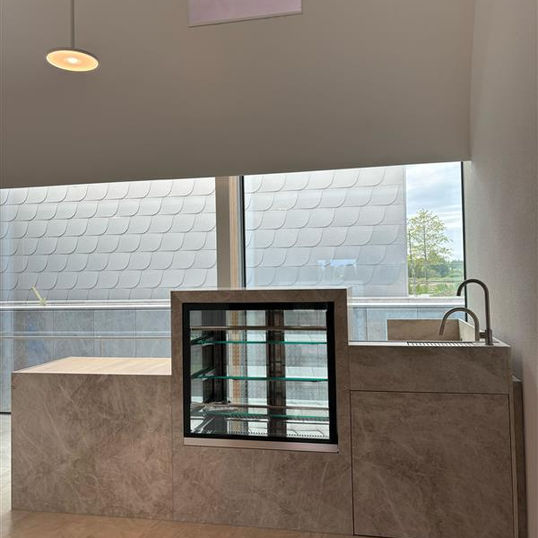Visiting Museum
Education
Explore
Inside the Exhibition
The Shtetls
Education
Stories About Shtetls
Collections
Events
Visiting Museum
Education

Located on the plateau overlooking the surrounding fields, the perennial garden offers a vivid reminder of the plant diversity native to the local landscape. The carefully curated mix of perennial species reflects the richness of nearby meadows and hedgerows, creating a living connection between cultivated spacesand the natural environment. These plants provide stable habitats and food sources for pollinators, birds, and beneficial insects, supporting a thriving web of biodiversity. By showcasing this variety, the perennial garden not only celebrates horticultural richness but also plays an active role in environmental stewardship and the conservation of native ecosystems.
At the garden’s edge, a stepped seating area beneath the canopy of oak trees offers a serene place for contemplation and observation of the quiet, surrounding landscape.

There are a few audio guide stations in the cemetery with stories and information.
Coneflower
Echinacea purpurea
Upright perennial with
pink-purple daisy-like flowers and a golden-brown center. Blooms from mid- summer to autumn. Also valued for its traditional medicinal properties. Great for pollinators.
Credits: Danyelab / Pixabay nuotr.

White Beauty Common Yarrow
Achillea millefolium
‘White Beauty’
Graceful perennial
wildflower that produces an abundance of huge, flat clusters, packed with creamy-white flowers.
Credits: by ipheos via Pixabay

Field Scabious
Knautia arvensis
Clump-forming perennial with bristly stems, hairy green leaves, and lilac-blue flowerheads in summer and autumn. Deep-rooted and loved by bees and butterflies. Great for naturalistic plantings.
Credits: by Jarmila via Pixabay
Russian Sage
Perovskia atriplicifolia
Upright sub-shrub with aromatic, grey-green, deeply divided leaves and white stems. Violet-blue flowers in airy plumes bloom late summer to autumn. Drought-tolerant and pollinator-friendly.
Credits: a-mblomma / Pixabay nuotr.
Culver’s root
Veronicastrum virginicum
Tall, upright perennial with elegant spikes of
white, pink, or purple flowers in summer. Known as Culver’s root, it brings a graceful, architectural presence to perennial plantings.
Credits: by TanteTati via Pixabay
There are a few audio guide stations in the cemetery with stories and information.
-
Achillea millefolium ‘Lilac Beauty’, lilac beauty common yarrow
-
Achillea millefolium ‘White Beauty’, white beauty common yarrow
-
Agastache foeniculum, blue giant hyssop
-
Anemone nemorosa, wood anemone
-
Athyrium filix-femina, lady fern
-
Calamagrostis × acutiflora ‘Karl Foerster’, Karl Foerster feather reed grass
-
Carex morrowii, Japanese sedge
-
Convallaria majalis, lily of the valley
-
Deschampsia cespitosa, tufted hair grass
-
Echinacea purpurea, coneflower
-
Echinops ritro ‘Veitch’s Blue’, globe thistle
-
Eryngium yuccifolium, rattlesnake master
-
Galanthus nivalis, snowdrop
-
Helleborus niger, Christmas rose
-
Iris sibirica, Siberian iris
-
Knautia arvensis, field scabious
-
Luzula sylvatica, woodrush
-
Perovskia atriplicifolia, Russian sage
-
Salix rosmarinifolia ‘Angustifolia’, narrow-leaved olive willow
-
Veronicastrum virginicum, Culver’s root
There are a few audio guide stations in the cemetery with stories and information.
As visitors approach the museum building, the landscape gradually shifts in scale – from the expansive wetlands and fields to the more intimate garden spaces nestled between the museum volumes.
The wetlands consist of a series of lakes of varying depths, surrounded by tall grasses and flowering plants.
A characteristic feature of the typical Lithuania’s rural landscape, the orchard area includes apple trees that evoke the region’s agricultural heritage.













